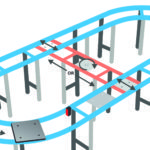 By Kate Nadeau | mk North America
By Kate Nadeau | mk North America
With all of the recent talk about automation and the factory of the future, it’s easy to forget the workhorse of nearly every processing or manufacturing plant — the conveyor. As technologies develop and factories get leaner and smarter, so does the conveyor. Big, bulky conveyors with oversized drive rolls and large industrial motors and rubberized belts are relics of a bygone era. Today’s conveyors are sleek, efficient, and flexible machines that fit in small locations and handle a variety of tasks well beyond moving product from point to point. As conveyor technology develops, there are a number of trends to watch.
Number 5 – Advanced materials for conveyors
In our ever-changing world, advanced materials are commonplace. The same can certainly be said about advanced materials in today’s manufacturing and processing environments. Developments in advanced materials are evident everywhere, and in particular can be seen foremost on conveyors.
DET food-grade metal-detectable belts from Chiorino are an excellent example of advanced conveyors. These belts are FDA, HACCP, and EU food regulation compliant, and are bacterial resistant and have excellent cleaning procedures. Additionally, these belts can detect parts up to three times smaller than other metal-detectable belts, ultimately making the food processed on lines using this belt safer for manufacturers and everyday consumers.
According to Rick Noble (representative partner for Chiorino America) Chiorino’s in-house chemists work consistently to improve the performance, longevity, and function of materials used in making conveyor belts.
Number 4 – Smarter motors and controllers on conveyors of all types
All around, it’s evident that motors and controllers are becoming smarter. This fast-paced technology sector can be seen in everything from cars to modern washing machines to high school science fairs to the modern factory. But motors and controllers aren’t merely becoming smarter. They are also becoming smaller and more streamlined, while their capacity and functionality increases. So it’s no wonder that conveyors benefit from these developments as well. Conveyor manufacturing companies can offer conveyors that have a motor and controller built into a single module. They can also offer control communications that work with specific factory communication systems. Servo stepper motors are used in a variety of indexing and positioning applications. The potential uses for today’s smart motors and controllers with conveyor systems are nearly limitless … though it’s important to ensure that the conveyor’s mechanical capabilities can match those of the electrical system employed with it.
Number 3 – Compact footprints for new industrial-conveyor designs
Space has always been a premium in many manufacturing and processing environments, and compact footprints are still on the trends list. Over recent years there have been many developments in conveyor design that allow conveyors to take up less space, and these developments will continue.
Conveyors with drive drum motors (which contain the motor internal to the conveyor’s drive pulley) are becoming more prevalent in today’s factories. And conveyor design is no longer limited to those with large-diameter drive drums. Today it is possible to drive a belt conveyor with a dc-powered drive drum motor that is less than two inches in diameter.
Drive drum motors and conveyors are not limited to belt conveyor styles; they are also available for plastic modular belt conveyors. These drive drums are outfitted on the external diameter with sprockets that engage the underside of the plastic modular belt. This is an expansion of the technology used for decades in the design and build of motorized roller conveyors. As this technology expands, additional conveyor types, like timing belt or chain conveyors, could benefit from the use of internal drive drum motors. These not only reduce the overall height and footprint of a conveyor, but according to drum-motor manufacturer Van der Graaf, drive drum motors also improve electrical and mechanical efficiencies.
Conveyor systems that carry product on uniform pallets and pallet-handling conveyor systems are also becoming more compact. Transfers between conveyors are streamlined, utilizing direction-changing modules and pallets with mating features. Additionally, pallet positioning devices, including stops, locates, and rotates are also being combined into all-in-one modules. This reduces the number of separate devices down the length of the conveyor, which means less floor space is required. Design innovations have also made asynchronous pallet conveyors; that recirculate the pallet possible. Previously separate conveyors as well as vertical transfer units were needed to recirculate an empty pallet back to the start of the line. But now, this can all be done in one conveyor such as the SPU 2040, which employs Vukollan pressure pads at the pulleys.

Number 2 – Conveyors with defined yet flexible purposes
Conveyors have always been versatile machines, able to fill the gap between processes. After all, they are the workhorse of the factory. And in that sense, they’ve had defined purposes for a while. For example, a conveyor used in a commercial bakery is not the same as one used to weld automotive parts.
So why have conveyors with a defined purpose become a trend? Specific-function conveyors are necessary because they’re unique in their defined purposes. Going forward, it will be more common to find conveyors outfitted with light panels for vision applications, scales and meters for weighing and measuring applications, or vacuums for precise or complex transporting applications. Adjustable-width conveyors will also gain in use because a single conveyor for carrying parts of different lengths and widths is more desirable over multiple conveyors or conveyors that require complex changeovers.
“We are seeing more and more requests for conveyors designed for a specific task, yet at the same time the conveyor also needs to be able to handle multiple products of different sizes,” said Tom Schaffner, sales and business development manager for mk North America.
“Take for example a recent job where we were tasked with designing a conveyor that would act as a storage device and recirculate the product which was glass vials. The glass vials came in a wide variety of sizes and with various bottom surfaces. Requests like this are common and mk’s conveyors and engineers are up for the challenge.”

Number 1 – Conveyors getting smarter
With all of recent the innovations in automation and robotics, it’s no wonder that conveyors are also getting smarter. In addition to the increased functionality of motors and controllers as described above, conveyors are also being outfitted with additional technologies. The world still has a place for “dumb” conveyors that simply move product from A to B, but there is increased demand for conveyors that can talk to the other machines and robots on the line. Developments in software, hardware, and advancements in computerization make it all possible. However, the technology isn’t limited to items “added” to conveyors.
Conveyors themselves benefit from smarter designs. Take for instance Intralox’s AIM belt and conveyor technology. Designed specifically for use in the primary packaging areas of food processing plants, AIM takes all of the features and benefits of Intralox’s ARB belting and adapts it for use in washdown areas.

AIM belting and conveyors allow for merging, switching, and single- and multi-zone sorting via a single conveyor. Gone are the designs of yesteryear that required slow, aggressive, and dangerous equipment to achieve automation.
“The benefits of AIM include reducing non-value-added labor, increasing throughput (by allowing higher line speeds and eliminating product damage) and enhancing process flexibility with a simple, cleanable, and reliable solution,” said Max Correa, product manager at Intralox.
These are just five of the many conveying trends we’ll continue to see. These trends are likely to grow further in the coming years, as conveying technology adapts along with the growing automation trend. Working with conveyor manufacturers and conveyor part suppliers who have an eye on the future will help ensure your line employs the most cutting-edge innovations.







Leave a Reply
You must be logged in to post a comment.